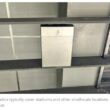Microwave path design: The basics
Part 4-This series of four articles is a primer on some of the propagation-related basics of microwave path design. This last installment discusses path reliability.
Preceding installments in this series have described basic considerations: * Determining whether a proposed path is "line-of-sight." * Evaluating path clearances with regard to refractive effects. * Evaluating path clearances with regard to Fresnel zones. * Considering path reflections. * Deriving a power budget and fade margin.
This concluding article covers path reliability.
Path reliability
Usually, microwave links are designed to meet a specific reliability factor. Reliability may also be termed "availability" and is expressed as a percentage. It represents the percentage of time the link is expected to operate without an outage caused by propagation conditions. The Bell standard for short-haul propagation reliability is 99.995% (minimum), while requirements for high-capacity, long-haul may be 99.9999%. "Unavailability" or the probability of an outage (because of propagation conditions) is often referred to and, if expressed in percentage, the value is determined by subtracting the availability (expressed as a percentage) from 100. For example, a short-haul reliability (availability) factor of99.995% can also be expressed as an unavailability factor of 0.005%.
Availability and unavailability are referenced to a year. In other words, if the unavailability is 0.001%, it could also be stated there will be: [365.25(days/yr)* 24(hr/day) * 60 (min/hr) * (0.001/100)]= 5.26 minutes of unavailability (outage) per year.
The propagation-related unavailability is derived from Equation 1 below. This equation is used as an approximation for the one-direction effects of multipath fading with various terrain and atmospheric conditions.
[Eq. 1] where Pm = Outage probability (unavailability) due to multipath fading. D = path length (in miles). f = frequency (in GHz). F = fade margin of the path (in dB). a = one of the following generalized terrain factors: 4: very smooth (including water). 1: average, some roughness. 1/4: very rough. b = one of the following generalized climate factors: 1/2: hot, humid. 1/4: normal, temperate. 1/8: very dry. (Note that the result of this equation must be multiplied by 100 in order to be expressed as a percentage.)
Another factor that can affect path reliability is rain attenuation, particularly past 10GHz. At these higher frequencies, the wavelength becomes short enough that rain droplets (depending on their size and shape) can present themselves as obstructions to the path. This occurs when the diameter of the droplets approach 1/4 wavelength of the frequency being used. The maximum instantaneous intensity of the rainfall and the percentage of the total path within the rain cell are other factors to be considered.
Because rain rates differ by geographic location, statistics for the particular area of interest must be obtained. Commercial path design software typically has this information in tables, requiring the user simply to select the geographic location of the proposed path. The values for that area are then accessed. The National Weather Bureau also maintains this information for various cities throughout the United States.
Increasing path reliability
One method of increasing path reliability is to increase the fade margin. If the design engineer dictates a particular fade margin requirement from the start, the power budget can be determined in a particular sequence. Knowing the noise threshold of the receiver being used (-dBm) and the required fade margin, the nominal signal level into the receiver can be determined (noise threshold [-dBm] plus fade margin [+ dB] = nominal receive level [-dBm]). The difference in decibels between the transmitter RF output level (+ dBm) on one end of the path and the desired receive signal level (RSL) on the other end of the path will be the maximum allowable net path loss. Because path distance and antenna heights are known, free space and atmospheric losses, along with all hardware losses on both ends, can be determined and will exceed this allowable net path loss by some amount (measured in decibels). The amount by which it is exceeded will be the necessary combined gain of the antennas on each end of the path. To achieve this required gain, proper antenna reflector diameters must be selected.
Parabolic ("dish") antennas typically have gain efficiencies of 55% to 65%.
Using an efficiency of 55%, the gain of a parabolic antenna can be calculated as follows:
G=20(log 10)B+20(log 10)F+7.5 [Eq. 2]
where G = gain over an isotropic antenna. B = parabola diameter in feet. F = frequency in GHz.
After a proposed microwave path has been evaluated with regard to reliability, the calculations may show that it will not meet the required standards. In such situations, additional techniques known as diversity methods may be employed.
One such technique is space diversity, which involves the addition of another receive antenna, separated in distance from the first, as shown in Figure 1 above. An additional receiver and associated switching/combining equipment will also be needed. The additional "diversity" antenna is usually mounted on the same tower structure, yet vertically separated from the site's original receive antenna. This diversity antenna is connected to the diversity receiver. This additional equipment essentially creates another microwave path between the two sites. Receiver switching and combining equipment then senses which receiver has the troubled signal (if fades occur) and switches that receiver "off-line."
One drawback of space diversity is increased cost. Tower heights must be greater to achieve sufficient vertical antenna separation. In some cases, the existing tower structure might have to be retrofitted to handle the additional wind loading created by the diversity antenna. The diversity antenna, receiver and combining and switching equipment create additional cost.
When spacing is adequate between antennas, there should be little correlation between the two paths with regard to propagation characteristics. Improvement in reliability comes from the reduced probability that both paths will be adversely affected by fading at the same time.
In general, more vertical spacing between antennas offers less path correlation and better path reliability. The rule of thumb for antenna spacing is as follows: 60-80 feet at 2GHz, 45-50 feet at 4GHz, 30-40 feet at 6GHz and 25-30 feet at 11GHz.
The following modified form of Arvids Vigants' fade reduction factor equation can be used to estimate the improvement offered by space diversity: I[sub]sd= [(7 * 10^-5 * f * s^2 * 10^(f/10)]/D [Eq. 3]
where Isd = improvement factor (space diversity). f = frequency in GHz. s = vertical antenna spacing, in feet, between centers. D = path length in miles. F = path fade margin (if one antenna's path has a smaller fade margin, use that figure).
Frequency diversity is another method used to increase path reliability. Microwave transmitters operating on two frequencies (with a typical in-band diversity spacing of about 2%), and sometimes in two frequency bands (called crossband diversity), are used to transmit the same information to separate receivers at the other end of the path.
Reliability improvement comes from the reduced chances of fading occurring on both frequencies (or frequency bands) at the same time.
Frequency diversity does not require the vertical antenna spacing used in space diversity, and therefore reduces tower cost. It does, however, require the use of more spectrum because it uses two sets of frequencies.
Because available frequencies are in limited supply, the FCC disallows the use of frequency diversity except under certain conditions. Test comparisons between space and frequency diversity indicate that improvements realized with space diversity are generally greater than those achieved with frequency diversity.
A general formula to calculate the improvement factor given by frequency diversity is as follows:
I[sub]fd = K * (change in f/f) * 10^(F/10) [Eq. 4]
where Ifd = frequency diversity improvement factor.
Change in f/f = frequency diversity spacing (percent 4 100). F = fade margin. K = 1/2 for 4 GHz band. 1/4 for 6 GHz band. 1/8 for 8 GHz band. 1/12 for 12 GHz band.
(The values of K shown above for the 8GHz and 12GHz bands are GTE-Lenkurt engineering estimates based on work from W.T. Barnett that dealt strictly with the 4GHz and 6GHz bands.)
Neither space diversity nor in-band frequency diversity provide improvement against rain attenuation, although out-of-band frequency diversity (such as 6GHz/12GHz) does.
Under superrefractive atmospheric conditions, negative values of K can exist where the path bows skyward at mid-path and comes downward at the ends. This will create a wavefront that will arrive at the antenna with a greater vertical angle than normal (see Figure 2 above). Because microwave antenna beamwidths can be small, this increased vertical arrival angle may be outside the antenna's half-power beamwidth. The received signal level realized may be sufficiently low to cause noise problems or even an outage. This has been termed "antenna decoupling."
A method of reducing this effect is to use a special angle diversity feed horn arrangement that essentially creates two vertically separated main lobes, so that if the signal level from the lower (normal) main lobe diminishes sufficiently because of the wavefront's increased arrival angle, the other (upper) lobe will be better oriented. Because most fades are due to reflections and multipath effects rather than this anomalous superrefractive condition, angle diversity offers only a limited improvement factor over that of a non-diversity path under typical path conditions.
Hybrid diversity is where both frequency and space diversity are employed simultaneously. However, most of the improvement comes from the effect of the space diversity.
The following equation is used when calculating fade probabilities with various methods of diversity:
U[sub]div = (P[sub]m)/I [Eq. 5]
where Udiv = unavailability or probability of outage (using some diversity method). Pm = annual unavailability (non-diversity) due to multipath (Eq. 1). I = diversity improvement factor (Eq. 3 and Eq. 4).
In multiple-hop microwave systems, the overall reliability figure (expressed as a percentage) is obtained by taking the sum of the unavailability figures (as a percentage) for each hop, and subtracting that figure from 100.
Conclusion
Many other considerations go into the complete design of a microwave path and communications link. Additionally, each of the points discussed can be taken in much greater depth. Volumes of information are available to the interested reader from many of the large communications companies, both past and present.
This series of articles has offered a glimpse into some of the more fundamental propagation-related design considerations and will be of value to those just getting their feet wet in the microwave communications field.
Read More:
References "Antenna Decoupling," GTE-Lenkurt Demodulator, March/April 1978. Laine, R.U., "Determining Antenna Heights for Coastal Areas," Lenkurt Electric, Monograph 197. Llanes, Cesar L., "6-Gigahertz Space-Diversity Digital Microwave Test Link," Los Angeles County Internal Services Department, ITS Engineering Study, Los Angeles, Nov. 1989. "Multipath Fading," Demodulator, GTE-Lenkurt, Nov. 1967. "Space Diversity," GTE-Lenkurt Demodulator, May 1973. White, R.F., Engineering Considerations for Microwave Communications Systems, 4th Ed., GTE-Lenkurt, San Carlos, CA, 1983.
Acknowledgments A special thanks to Cesar Llanes for answering so many questions through the years.

















What is the exact meaning of
What is the exact meaning of DHU on site plan for tower.